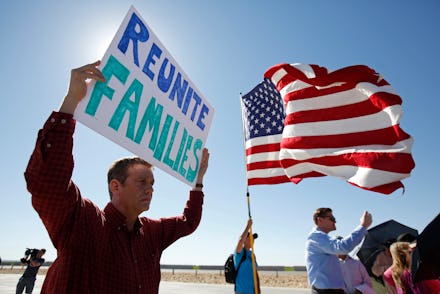Trump administration says it can locate separated children, but reunification will be a challenge

Amid ongoing outrage about the Trump administration’s handling of the separation of more than 2,000 immigrant children from their parents, the departments of Homeland Security and Health and Human Services issued guidance Saturday claiming the government is attempting to reunify the families.
“The U.S. government knows the location of all children in its custody and is working to reunite them with their families,” the government fact sheet noted, going on to claim there is a “well-coordinated” process for reunification in place and that the locations of separated parents and children are tracked through through a central database. According to the release, 2,053 separated minors are being held in government-funded facilities as of June 20, and 522 children have already been reunified with their families.
Sen. James Lankford (R-Okla.) backed up those claims Sunday in an interview on Meet the Press.
“Let me clarify this. We know where every single child is,” Lankford said. “These are career professionals that work with HHS. They know where every child is to be able to connect them to their parent or their relative that came.”
Despite the White House’s insistence it can locate the children in its care, major challenges seemingly remain when it comes to family reunification.
USA Today reported Friday that the government began issuing identification numbers to families being separated the previous week; prior to that, however, there was reportedly no system for keeping track of parents and children concurrently, according to the New Yorker. As a result, many parents are unaware of where their child is being held, and the reported government database may not be able to link many of the separated families.
The Washington Post also reported instances of bureaucratic errors that leave government officials unaware whether a child was separated from their family or had arrived at the border by themselves. Further, some young children may not be able to provide their parents’ complete names.
The Texas Civil Rights Project told the Post it had tracked down only two children out of more than 300 families the organization is representing. Though the government reportedly gave immigrant parents a flyer with information for the Office of Refugee Resettlement, which handles the minors’ detainment, lawyers cited by the Post noted that many immigrants did not receive the flyers, and the number proved unhelpful in many instances.
“Our office does what it can,” Erik Hanshew, an assistant federal public defender in El Paso, Texas, wrote in an op-ed for the Washington Post. “If we’re lucky, we can determine that a client’s child is at least in the vicinity of El Paso. But those ‘answers’ come only after calls and calls and calls to the Office of Refugee Resettlement. The process is so chaotic and byzantine that our office has tasked investigators, paralegals, administrative staffers and interns with calling and sitting on hold, waiting to speak to someone. Some of our investigators have waited nearly an hour just to get a person on the line. And once they find someone, their inquiries are met with vague statements that the child is in the United States.”
It is unclear how this fraught process will change following the federal guidance released Saturday. Though the fact sheet noted enhanced procedures for communication between parents and children, it did not specify any mechanisms to link parents with their children in the first place.
“When the family separation policy was implemented, there doesn’t seem to have been any planning as to how parents were going to know where their children were, how children were going to know where their parents were, how they were going to be able to communicate and how they would be able to be reunited,” Mark Greenberg, an expert at the Migration Policy Institute who previously worked for the HHS, told CNN. “As a threshold matter, it will be very difficult to do reunification if parents and children don’t know where each other are.”